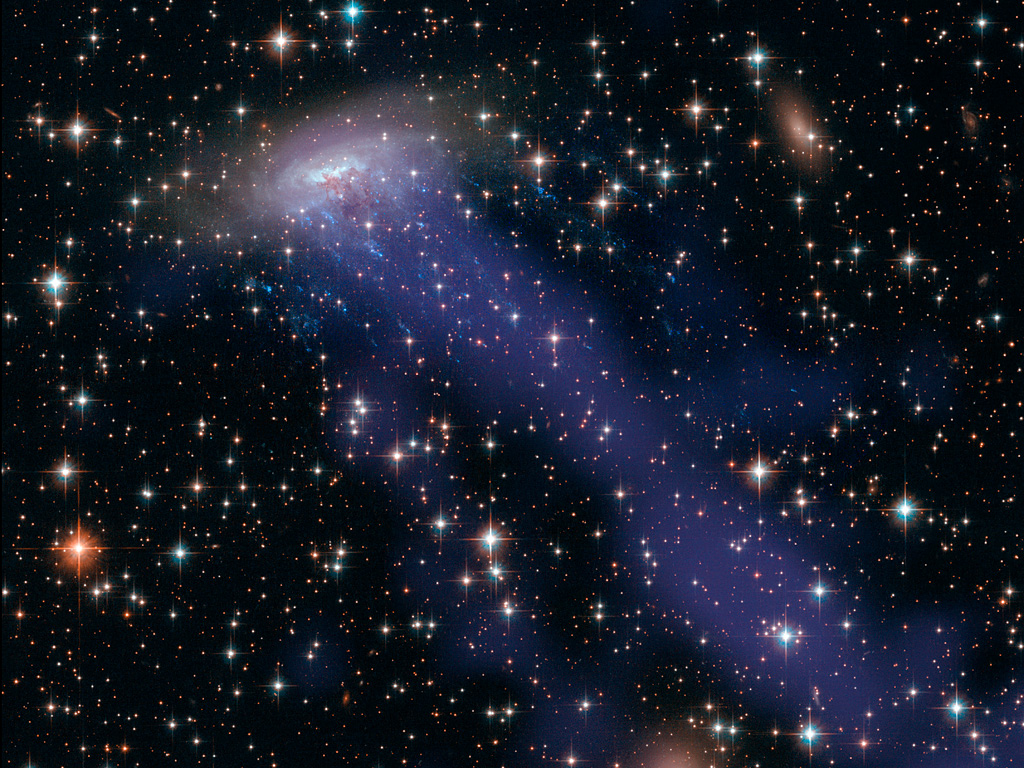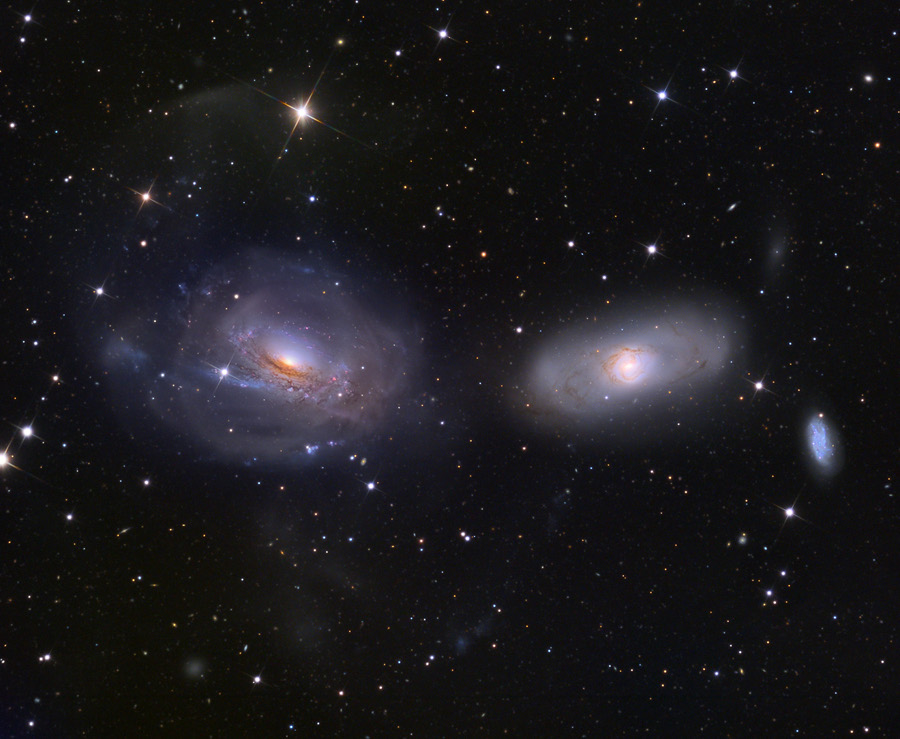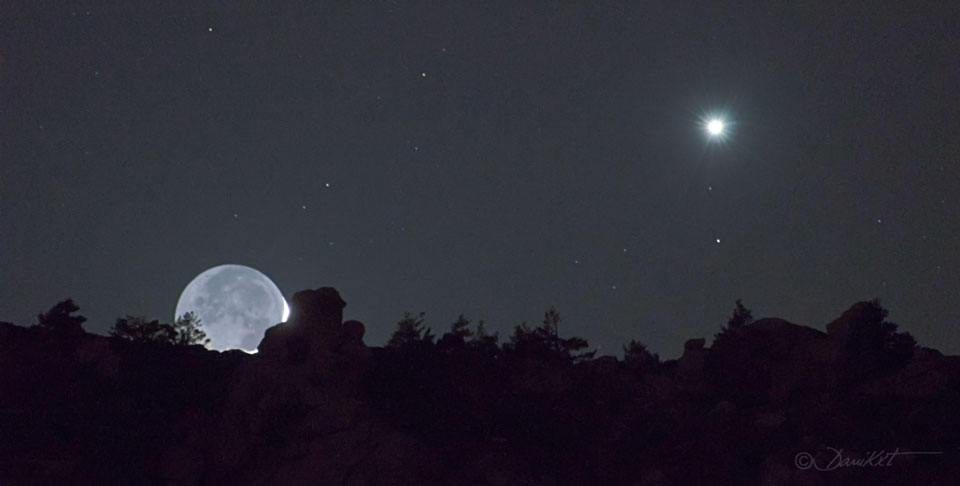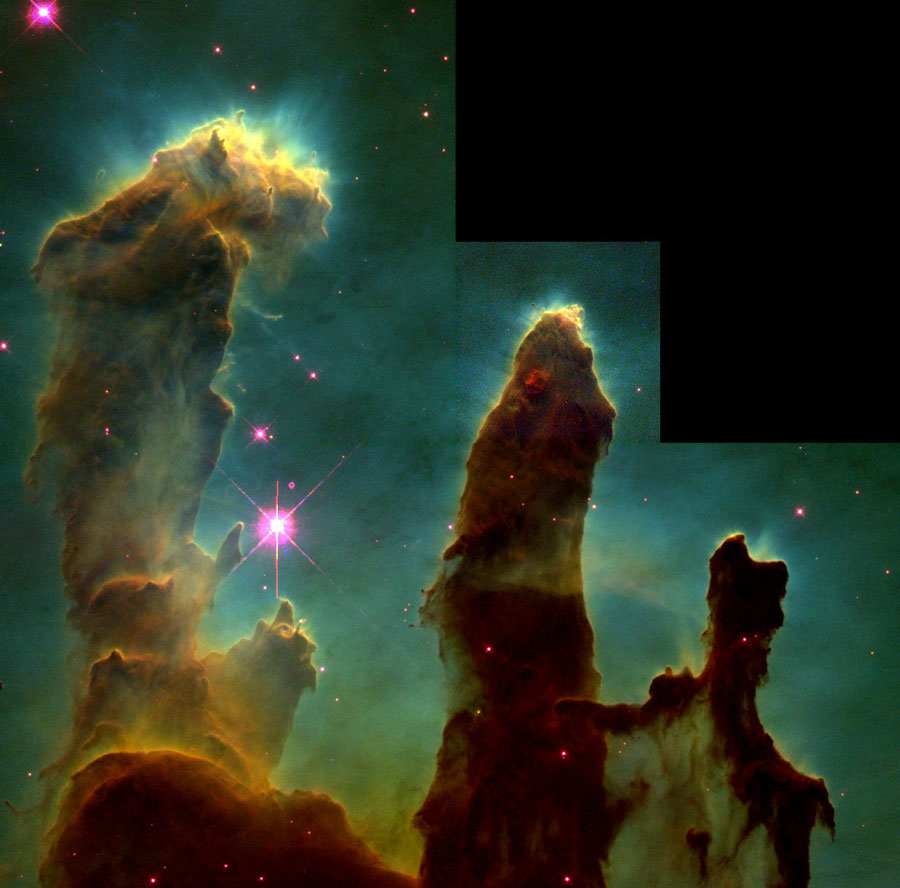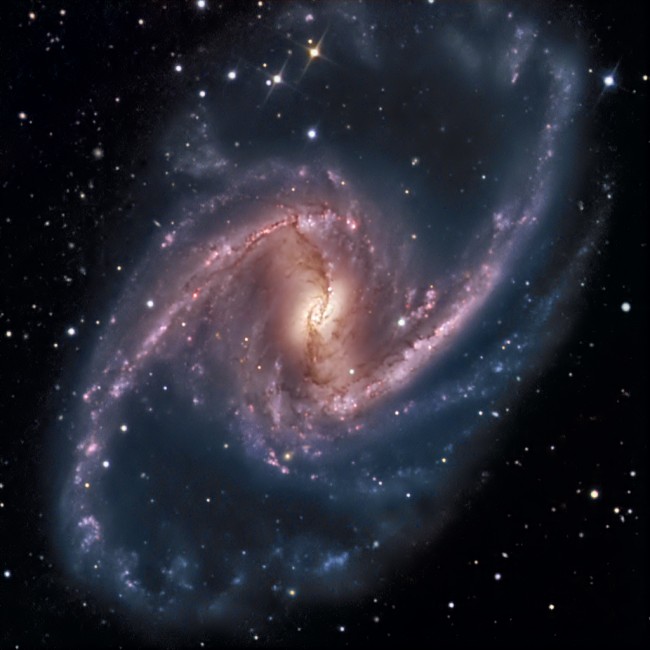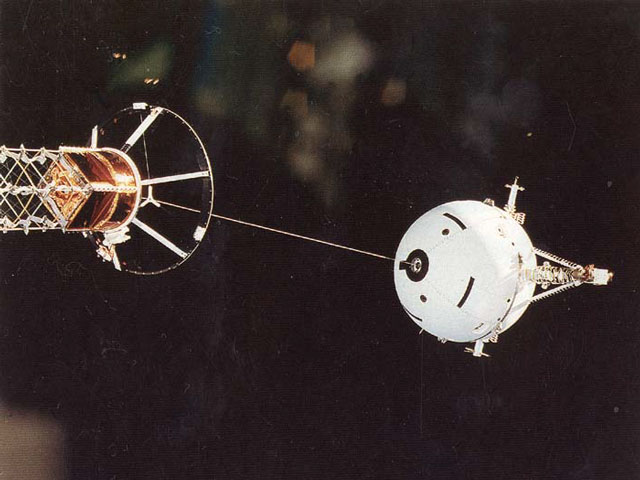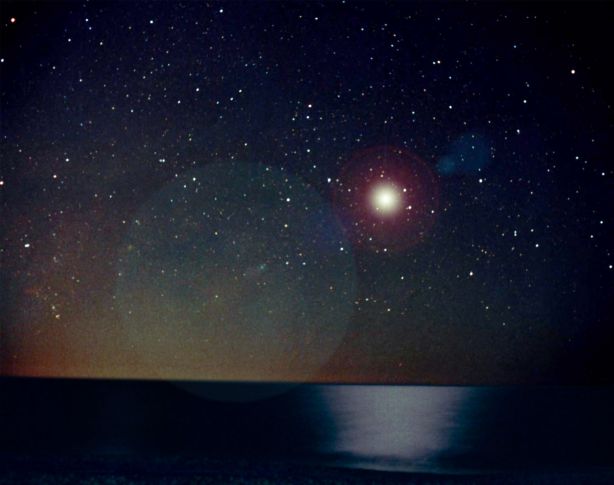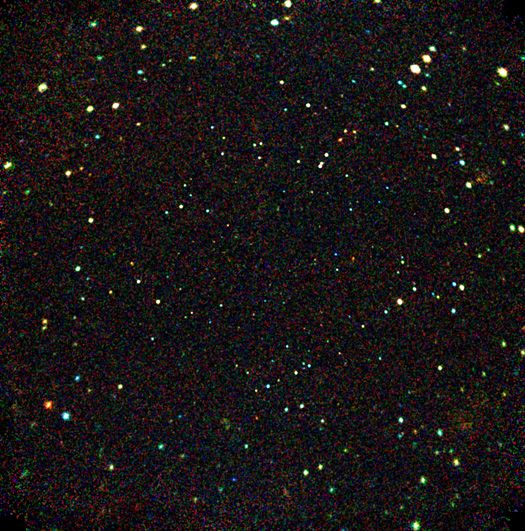| << Previous | Index | Next >> |
2015 Near the March 20 equinox the cold clear sky over Longyearbyen, Norway, planet Earth held an engaging sight, a total eclipse of the Sun. The New Moon's silhouette at stages just before and after the three minute long total phase seems to sprout glistening diamonds and bright beads in this time lapse composite of the geocentric celestial event. The last and first glimpses of the solar disk with the lunar limb surrounded by the glow of the Sun's inner corona give the impression of a diamond ring in the sky. At the boundaries of totality, sunlight streaming through valleys in the irregular terrain along the Moon's edge, produces an effect known as Baily's Beads, named after English astronomer Francis Baily who championed an explanation for the phenomenon in 1836. This sharp composition also shows off the array of pinkish solar prominences lofted above the edge of the eclipsed Sun.
2014 Spiral galaxy ESO 137-001 hurtles through massive galaxy cluster Abell 3627 some 220 million light years away. The distant galaxy is seen in this colorful Hubble/Chandra composite image through a foreground of the Milky Way's stars toward the southern constellation Triangulum Australe. As the spiral speeds along at nearly 7 million kilometers per hour, its gas and dust are stripped away when ram pressure with the cluster's own hot, tenuous intracluster medium overcomes the galaxy's gravity. Evident in Hubble's near visible light data, bright star clusters have formed in the stripped material along the short, trailing blue streaks. Chandra's X-ray data shows off the enormous extent of the heated, stripped gas as diffuse, darker blue trails stretching over 400,000 light-years toward the bottom right. The significant loss of dust and gas will make new star formation difficult for this galaxy. A yellowish elliptical galaxy, lacking in star forming dust and gas, is just to the right of ESO 137-001 in the frame.
2013 Bright spiral galaxy NGC 3169 appears to be unraveling in this cosmic scene, played out some 70 million light-years away just below bright star Regulus toward the faint constellation Sextans. Its beautiful spiral arms are distorted into sweeping tidal tails as NGC 3169 (left) and neighboring NGC 3166 interact gravitationally, a common fate even for bright galaxies in the local universe. In fact, drawn out stellar arcs and plumes, indications of gravitational interactions, seem rampant in the deep and colorful galaxy group photo. The picture spans 20 arc minutes, or about 400,000 light-years at the group's estimated distance, and includes smaller, dimmer NGC 3165 at the right. NGC 3169 is also known to shine across the spectrum from radio to X-rays, harboring an active galactic nucleus that is likely the site of a supermassive black hole.
2012 What just above that ridge? The Moon. Specifically, the Earth's Moon was caught just above the horizon in a young crescent phase. The familiar Moon might look a bit odd as the exposure shows significant Earthshine -- the illumination of the part of the Moon hidden from direct sunlight by the sun-reflecting Earth. Also captured in the image is the bright planet Venus on the right. Venus and Jupiter passed only three degrees from each other last week during a photogenic planetary conjunction. The above image was taken two days ago near Madrid, Spain. The foreground horizon silhouette includes some of the Seven Peaks of the Sierra de Guadarrama mountain range. Just a few minutes after this picture was taken, the Moon set.
2011
Credit & Copyright: Terje Sørgjerd; Music: Gladiator Soundtrack: Now we are Free
2010 It has become one of the most famous images of modern times. This image, taken with the Hubble Space Telescope in 1995, shows evaporating gaseous globules (EGGs) emerging from pillars of molecular hydrogen gas and dust. The giant pillars are light years in length and are so dense that interior gas contracts gravitationally to form stars. At each pillars' end, the intense radiation of bright young stars causes low density material to boil away, leaving stellar nurseries of dense EGGs exposed. The Eagle Nebula, associated with the open star cluster M16, lies about 7000 light years away. The pillars of creation were again imaged by the orbiting Chandra X-ray Observatory, and it was found that most EGGS are not strong emitters of X-rays.
2009 Small asteroid 2008 TC3 fell to Earth at dawn on October 7, 2008, tracking through the skies over the Nubian Desert in northern Sudan. That event was remarkable because it was the first time an asteroid was detected in space before crashing into planet Earth's atmosphere. It was generally assumed the asteroid itself had completely disintegrated to dust. But, based on satellite and ground observations of the atmospheric impact event, Dr. Mauwia Shaddad of the University of Khartoum, aided by Dr. Peter Jenniskens of the SETI Institute and NASA Ames Research Center, led an expedition of students and staff to the area, combing the desert for surviving fragments. On December 6, 2008, two hours after their search began, the first meteorite was found. The team ultimately collected some 280 small meteorites, now called Almahata Sitta, with a total mass of about 5 kilograms -- the first material recovered from a known asteroid. In stark contrast to the lighter-colored stones, the black fragment in the picture is Almahata Sitta meteorite number 15. About 4 centimeters in diameter, it is seen as it came to rest on the desert floor.
Editor's note: In Arabic, Almahata Sitta is "Station Six": a railway stop in the Nubian desert where witnesses reported seeing the bright fireball meteor.
2008 How far can you see? Even the faintest stars visible to the eye are merely hundreds or thousands of light-years distant, all well within our own Milky Way Galaxy. Of course, if you know where to look you can also spot the Andromeda Galaxy as a pale, fuzzy cloud, around 2.5 million light-years away. But staring toward the northern constellation Bootes on March 19th, even without binoculars or telescope you still could have witnessed a faint, brief, flash of light from a gamma-ray burst. The source of that burst has been discovered to lie over halfway across the Universe at a distance of about 7.5 billion light-years. Now holding the distinction of the most distant object that could be seen by the unaided eye and the intrinsically brightest object ever detected, the cosmic explosion is estimated to have been over 2.5 million times more luminous than the brightest known supernova. The monster burst was identified and located by the orbiting Swift satellite, enabling rapid distance measurements and follow-up observations by large ground-based telescopes. The fading afterglow of the gamma-ray burster, cataloged as GRB080319B, is shown in these two panels in X-rays (left) and ultraviolet light (right).
2007 Barred spiral galaxy NGC 1365 is truly a majestic island universe some 200,000 light-years across. Located a mere 60 million light-years away toward the chemical constellation Fornax, NGC 1365 is a dominant member of the well-studied Fornax galaxy cluster. This impressively sharp color image shows intense star forming regions at the ends of the bar and along the spiral arms, as well as details of dust lanes cutting across the galaxy's bright core. At the core lies a supermassive black hole. Astronomers think NGC 1365's prominent bar plays a crucial role in the galaxy's evolution, drawing gas and dust into a star-forming maelstrom and ultimately feeding material into the central black hole.
2006 How often does an asteroid whiz by the Earth? The above time-lapse animation follows the orbit of the Earth around the Sun for two months in 2002 as numerous asteroids, also known as minor planets, approach and pass by. Some asteroids appear out of nowhere as they are plotted only when they were discovered. Most asteroids plotted were discovered only during the previous year. Although none of the plotted objects came inside the orbit of our Moon, our Solar System is filled with objects as small as bits of sand, usually left by a comet, that appear as meteors as they streak into the Earth's atmosphere every day. The only objects displayed are those visible from Earth closer than 20 million kilometers, color coded by three-dimensional distance. In comparison, the Earth is a relatively small target having a radius of about 6,400 kilometers. One significant research area in modern astronomy involves trying to find the majority of asteroids that could pose a future collision threat with Earth.
2005 One of the greatest unrequited legends of outer space is the tether. Tethers, long strands of material, hold the promise of stabilizing satellites, generating electricity, and allowing easy transportation. Possibly the most extreme vision of the space tether is the space elevator popularized by Arthur C. Clarke, where a tether is constructed that connects the ground to geosynchronous orbit. One problem is strength - it is difficult to make a long useful tether that does not snap. To help realize more of the tremendous potential of space tethers, NASA and the SpaceWard Foundation have issued the Centennial Tether Challenge, promising a monetary reward for the best space tether that exceeds a minimum standard. Pictured above is the deployment of the Tethered Satellite System 1 (TSS-1) by the space shuttle Altantis in 1992. Like other tested tethers, TSS-1 failed to live up to its promise, although many valuable lessons were learned.
2004 Seemingly adrift in a cosmic sea of stars and gas, this delicate, floating apparition is cataloged as NGC 7635 -- The Bubble Nebula. In this wide-angle view, the Bubble nebula lies at the center of a larger complex of shocked glowing gas about 11,000 light-years distant in the fair constellation Cassiopeia. NGC 7635 really is an interstellar bubble, blown by winds from the brightest star visible within the bubble's boundary. The bubble's expansion is constrained by the surrounding material. About 10 light-years in diameter, if the Bubble nebula were centered on the Sun, the Sun's nearest stellar neighbor, Alpha Centauri, would also be enclosed. This breathtaking picture is a combination of telescopic digital images made through broad color filters along with a narrow filter intended to transmit only the red light emitted by excited hydrogen atoms.
2003 A new star, likely the brightest supernova in recorded human history, appeared in planet Earth's sky in the year 1006 AD. The expanding debris cloud from the stellar explosion is still visible to modern astronomers, but what did the supernova look like in 1006? Astronomer Tunç Tezel offers this suggestion, based on a photograph he took on February 22, 1998 from a site overlooking the Mediterranean south of Antalya, Turkey. On that date, bright Venus and a waning crescent Moon shone in the early morning sky. Adopting recent calculations which put the supernova's apparent brightness between Venus and the crescent Moon, he digitally superposed an appropriate new star in the picture. He placed the star at the supernova's position in the southerly constellation of Lupus and used the water's reflection of moonlight in the final image. Tezel hopes to view the total solar eclipse of 29 March 2006 from this same site -- on the 1,000th anniversary of Supernova 1006.
2002 The Centaurus Cluster is a swarm of hundreds of galaxies a mere 170 million light-years away. Like other immense galaxy clusters, the Centaurus Cluster is filled with gas at temperatures of 10 million degrees or more, making the cluster a luminous source of cosmic x-rays. While individual galaxies are not seen here, this false-color x-ray image from the Chandra Observatory does reveal striking details of the central region's hot cluster gas, including a large twisted plume about 70,000 light-years long. Colors represent temperatures indicated by the x-ray data with red, yellow, green, and blue shades ranging in order from cool to hot. The plume of gas alone is estimated to contain material equivalent to about one billion times the mass of the Sun. It may be a wake of gas condensing and cooling along the path of the massive, dominant central galaxy moving through the cluster.
2001 Officially the Chandra Deep Field - South, this picture represents the deepest ever x-ray image of the Universe. One million seconds of accumulated exposure time with the orbiting Chandra X-ray Observatory went in to its making. Concentrating on a single, otherwise unremarkable patch of sky in the constellation Fornax, this x-ray image corresponds to the visible light Hubble Deep Field - South released in 1998. Chandra's view, color coded with low energies in red, medium in green, and high-energy x-rays in blue, shows many faint sources of relatively high-energy x-rays. These are likely active galaxies feeding supermassive central black holes and large clusters of galaxies at distances of up to 12 billion light-years. The stunning picture supports astronomers' ideas of a youthful universe in which massive black holes were much more dominant than at present.
2000 Unspeakable beauty and unimaginable bedlam can be found together in the Trifid Nebula. Also known as M20, this photogenic nebula is visible with good binoculars towards the constellation of Sagittarius. The energetic processes of star formation create not only the colors but the chaos. The red-glowing gas results from high-energy starlight striking interstellar hydrogen gas. The dark dust filaments that lace M20 were created in the atmospheres of cool giant stars and in the debris from supernovae explosions. Which bright young stars light up the blue reflection nebula is still being investigated. The light from M20 we see today left perhaps 3000 years ago, although the exact distance remains unknown. Light takes about 50 years to cross M20.
1999 Almost every object in the above photograph is a galaxy. The Coma Cluster of Galaxies pictured is one of the densest clusters known - it contains thousands of galaxies. Each of these galaxies house billions of stars - just as our own Milky Way Galaxy does. Although nearby when compared to most other clusters, light from the Coma Cluster still takes hundreds of millions of years to reach us. In fact, the Coma Cluster is so big it takes light millions of years just to go from one side to the other! Most galaxies in Coma and other clusters are ellipticals, while most galaxies outside of clusters are spirals. The nature of Coma's X-ray emission is still being investigated.
1998 Orbiting 1,075 miles above the Earth, a 250 foot wide, inflated, reinforced nylon "wheel" was conceived in the early 1950s to function as a navigational aid, meteorological station, military platform, and way station for space exploration by rocket pioneer Wernher von Braun. The wheel-shaped station could be easily rotated creating artificial gravity so that the astronauts would not suffer the effects of prolonged weightlessness. Von Braun and his team favored building a permanently occupied Earth orbiting space station from which to stage a lunar exploration program. But in the 1960s NASA adopted the Apollo Program, which called for astronauts to transfer to a landing vehicle after achieving lunar orbit, bypassing the construction of von Braun's wheel.
1997 It has been suggested that Comet Hale-Bopp will become the most viewed comet in Human history. Presently, for denizens of the Earth's northern hemisphere, this bright comet is certainly a lovely and inspiring sight -- visible here crowning the sky above Cortina d'Ampezzo, Italy on March 20. Based on orbital calculations, this comet's last passage through the inner Solar System was approximately 4,200 years ago. Principally because of changes caused by the gravitational influence of Jupiter, Hale-Bopp should pass this way again in a mere 2,380 years. Comets come from the outer reaches of the Solar System where they reside, frozen and preserved. Astronomers analyzing their structure and composition as comets swing near the Sun seek a glimpse of the conditions during the Solar System's formative years.
1996 NASA's Hubble Space Telescope captured this image of the near-nuclear region of Comet Hyakutake on March 25 as the comet approached within 9.3 million miles of the Earth. It covers a relatively "small" 2,000 mile wide area with the sunward direction toward the lower right (tailward is upper left). The image shows large amounts of dust jetting from the sunward side of the nucleus as the sun heats the surface of this dirty "orbiting iceberg". Pressure from sunlight eventually pushes the dust tailward and as the dust production increases, the already visually impressive tail will grow even brighter! The actual size of the nucleus is uncertain but is estimated to be 5-10 miles, similar to Comet Halley. As seen here, the brightest point is probably the tip of the strongest dust jet rather than the nucleus itself. A dramatic dust jet feature also appears to arise from the nightside but its true angle to our line of sight is difficult to judge. Some large fragments which have broken away from the comet nucleus are visible in the upper left of the image, producing dust tails of their own. Comet dust may represent primordial material from the formation of the solar system and NASA has plans for a comet dust sample return mission.
| << Previous | Index | Next >> |

